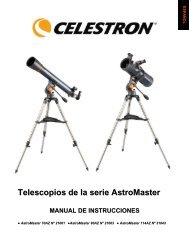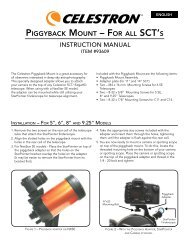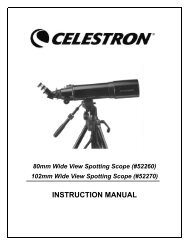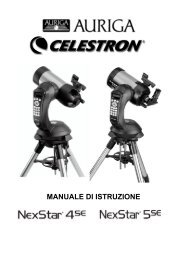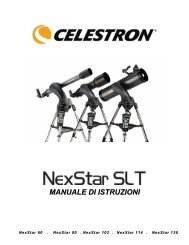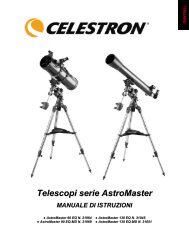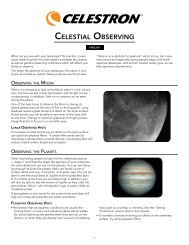2009-10 Celestron Telescope Catalog
2009-10 Celestron Telescope Catalog
2009-10 Celestron Telescope Catalog
You also want an ePaper? Increase the reach of your titles
YUMPU automatically turns print PDFs into web optimized ePapers that Google loves.
efraCtor advantages<br />
n Easy to set-up and use<br />
n Simple and reliable design requires little or no maintenance<br />
n Excellent for lunar, planetary and binary star observing especially in larger apertures<br />
n Good for terrestrial viewing<br />
n High contrast images with no secondary mirror or diagonal obstruction<br />
n Color correction is good in achromatic designs and excellent in apochromatic and fluorite designs<br />
n Sealed optical tube reduces image-degrading air currents and protects optics<br />
n Objective lens is permanently mounted and aligned<br />
refraCtor dIsadvantages<br />
n More expensive per inch of aperture than Newtonians or Catadioptrics<br />
n Heavier, longer and bulkier than equivalent aperture Newtonians and Catadioptrics<br />
n The cost and size factors limit the practical maximum size primary to smaller apertures<br />
n Some color aberration in achromatic designs (doublet)<br />
newtonIan refleCtor telesCope<br />
A Newtonian reflector uses a single concave mirror as its<br />
primary. Light enters the tube traveling to the mirror at<br />
the back end. Light is then “bent” forward in the tube to a<br />
single point, its focal plane. A flat mirror called a “diagonal”<br />
intercepts the light and points it out the side of the tube at<br />
right angles to the tube through the eyepiece. The eyepiece is<br />
placed there for easy viewing.<br />
Newtonian Reflector telescopes replace heavy lenses with<br />
mirrors to collect and focus the light, providing much more<br />
light gathering power for the money. You can have focal lengths up to <strong>10</strong>00 mm and still enjoy a telescope<br />
that is relatively compact and portable. Newtonian Reflector telescopes do require more care and<br />
maintenance because the primary mirror is exposed to air and dust. However, this small drawback does<br />
not hamper this type of telescope’s popularity with those who want an economical telescope that can still<br />
resolve faint, distant objects.<br />
Newtonian reflectors produce a “right-side-up image” but the image will appear rotated based on the<br />
location of the eyepiece holder in relation to the ground. Newtonian reflectors are best for astronomical<br />
use where right-side-up does not matter.<br />
newtonIan advantages<br />
n Lowest cost per inch of aperture compared to Refractors and Catadioptrics since mirrors can be produced<br />
at less cost than lenses in medium to large apertures<br />
n Reasonably compact and portable up to focal lengths of <strong>10</strong>00 mm<br />
n Excellent for faint deep sky objects such as remote galaxies, nebulae and star clusters due to the generally<br />
fast focal ratios (f/4 to f/8)<br />
n Adequate for lunar and planetary work<br />
n Good for deep sky astrophotography (but not as convenient and more difficult to use than Catadioptrics)<br />
n Free of color aberration due to the use of a primary mirror<br />
newtonIan dIsadvantages<br />
n Generally not suited for terrestrial applications<br />
n Slight light loss due to secondary (diagonal) obstruction when compared with Refractors<br />
38 mount and <strong>Telescope</strong> descriptions<br />
CatadIoptrIC telesCope<br />
Catadioptrics use a combination of mirrors and lenses<br />
to “fold” (reflect) the light path and form an image. In a<br />
Schmidt-Cassegrain, the light enters through a thin aspheric<br />
Schmidt correcting lens. It then strikes the spherical primary<br />
mirror. It is reflected back up the tube and intercepted<br />
by a small secondary mirror which reflects the light out<br />
an opening in the rear of the instrument where the image is formed at the eyepiece. Catadioptrics<br />
are the most popular and most modern type of telescope optical design and are marketed throughout the<br />
world in 3.5” and larger apertures.<br />
Catadioptric telescopes combine the practical advantages of lenses and mirrors while eliminating their<br />
disadvantages. They offer the clarity and contrast of refractors with the low aberration of reflectors. Catadioptrics<br />
have an average focal ratio of f/<strong>10</strong>, which is wide enough for all types of photography. They are also easier<br />
to maintain because all optical elements are solidly mounted and rigidly collimated. Catadioptric telescopes<br />
provide the best possible combination of light gathering power, long focal length, portability and affordability.<br />
sChmIdt-CassegraIn advantages<br />
n Very versatile, best all-purpose telescope design<br />
n Combines the optical advantages of both lenses and mirrors while eliminating their disadvantages<br />
n Excellent optics and razor sharp images over a wide field<br />
n Excellent for deep sky observing and astrophotography as well as terrestrial viewing<br />
n Very good for lunar, planetary and binary star observing<br />
n Focal ratio generally around f/<strong>10</strong>, it also has the best near focus capability of any type of telescope<br />
n Closed tube design reduces image-degrading air currents<br />
n Extremely compact and portable<br />
n Easy to use, durable and virtually maintenance free<br />
n Large apertures at reasonable cost and less expensive than equivalent aperture refractors<br />
n More accessories available than with other types of telescopes<br />
sChmIdt-CassegraIn dIsadvantages<br />
n More expensive than Newtonians of equal aperture<br />
n Slight light loss due to secondary mirror obstruction<br />
compared to refractors<br />
The Maksutov-Cassegrain is similar to the Schmidt-Cassegrain<br />
with essentially the same advantages and disadvantages.<br />
It uses a thick meniscus correcting lens with a strong curvature<br />
and a secondary mirror that is usually an aluminized spot on the corrector. The Maksutov secondary mirror<br />
is typically smaller than the Schmidt’s which gives it slightly better resolution for planetary observing.<br />
advantages of maksutov-CassegraIn Compared to sChmIdt-CassegraIn<br />
n Smaller secondary obstruction results in a slight increase in planetary detail and contrast<br />
n Less expensive to manufacture<br />
n Longer focal lengths resulting in higher magnifications for planetary viewing<br />
dIsadvantages of maksutov-CassegraIn Compared to sChmIdt-CassegraIn<br />
n Slightly heavier because of the thick meniscus correcting lens<br />
n Increased time to reach thermal stability in larger apertures over 90 mm<br />
n Longer focal lengths resulting in smaller field of views



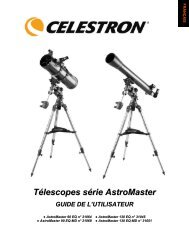

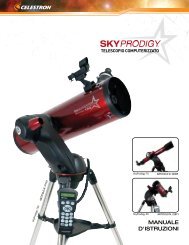
![Guía para realizar un ensablaje rápido [continuación] - Celestron](https://img.yumpu.com/14596837/1/190x245/guia-para-realizar-un-ensablaje-rapido-continuacion-celestron.jpg?quality=85)
